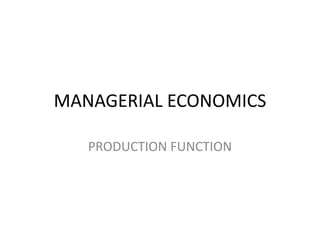
Production function
- 1. MANAGERIAL ECONOMICS PRODUCTION FUNCTION
- 2. PRODUCTION FUNCTION • PRODUCTION • Production is the process of converting an input into a more valuable output. • Inputs can normally be combined in more than one way to produce output. • Of all the possible combinations, there exists one which is the most efficient. • Production analysis aims at determining this optimal combination of inputs so as to minimize the costs and hence maximize profits for a given level of revenue. • Major production decisions relates to the budget for the purchase of inputs, distribution of the budget among the inputs, allocation of inputs to each output and the combination of outputs. • Dependency of inputs and outputs has to be understood and production function makes this process easy.
- 3. PRODUCTION FUNCTION Contd… • PRODUCTION FUNCTION • A Production Function is the technological relationship between the output and its inputs. • Factors of production viz. Land, Labor, Capital, Management and Technology determine output. • Q = f(Ld, L, K, M, T) • Q = Output • Ld = Land employed in production • L = Labor employed in production • K = Capital employed in production • M = Management employed in production • T = Technology employed in production
- 4. PRODUCTION FUNCTION Contd… • The importance of a factor of production varies from product to product • Example: • Factor of Agricultural Manufacturing Production product product • Land Most important Relative lower importance • Management and Technology Lesser significance Greater significance
- 5. PRODUCTION FUNCTION Contd… • Generally, for the analysis of production decision functions, labor and capital are the only two factor inputs considered for convenience. • Q = f(L,K) • For a given level of output of commodity Q, various combinations of L and K may be used. • When more of labor (than capital) is employed, the production process is known as labor intensive production technique • If more of capital is used in relation to labor, the production technique becomes labor intensive
- 6. PRODUCTION FUNCTION Contd… • PRODUCER’S EQUILIBRIUM • A producer is in equilibrium when he or she maximizes output for the given total outlay • Different combinations of labor and capital can be used to get the same level of output of a commodity
- 7. LAW OF VARIBALE PROPORTIONS • Definition of Law • The Law of Variable Proportions is the new name of the famous Law of Diminishing Returns. • →According to Stigler” "As equal increments of one input are added, the inputs of other productive services being held constant, beyond a certain point, the resulting increments of produce will decrease i.e., the marginal product will diminish". →According to Paul Samulson "An increase in some inputs relative to other fixed inputs will, in a given state of technology, cause output to increase, but after a point, the extra output resulting from the same addition of extra inputs will become less".
- 8. LAW OF VARIBALE PROPORTIONS Contd… • The law of variable proportions states that as the quantity of one factor is increased, keeping the other factors fixed, the marginal product of that factor will eventually decline. • This means that up to the use of a certain amount of variable factor, marginal product of the factor may increase and after a certain stage it starts diminishing. When the variable factor becomes relatively abundant, the marginal product may become negative. • Assumptions of Law. • →Constant technology--- This law assumes that technology does not change throughout the operation of the law. • →Fixed amount of some factors.—One factor of production has to be fixed for this law. • → Possibility of varying factor proportions—This law assumes that variable factors can be --changed in the short run.
- 9. LAW OF VARIBALE PROPORTIONS Contd… • Schedule:
- 10. LAW OF VARIBALE PROPORTIONS Contd… • ASSUMPTIONS: • A farmer has 30 acres of land for cultivation • Land is the fixed factor • Investment in the form of tube well and machinery is also fixed • Only labor is the variable factor in this example
- 11. RETURNS TO SCALE • Law of returns to scale represents the long term perspective of production analysis, when all factors of production are variable. • There are three types of return to scale: • Constant returns to scale • Increasing returns to scale • Decreasing returns to scale
- 12. CONSTANT RETURNS TO SCALE • This indicates that if all factors of production are increased in a given proportion, then the output produced would also increase in exactly the same proportion • That is, if the quantities of labor or capital or both are increased by 10%, output would also increase by 10%
- 13. INCREASING RETURNS TO SCALE • This indicates, when all factors are increased in a given proportion, output increases in a greater proportion • Thus, if labor and capital are increased by 10%, out increases by more than 10% • Increasing returns to scale may occur because of expansion in the scale of operation and greater productive efficiency of managers and labor due to greater specialization
- 14. DECREASING RETURNS TO SCALE • This indicates that output increases in less than proportion to the increase in factor inputs • This may be due to the scale of operation beyond the optimum plant capacity, over utilization of machineries resulting in wear and tear an break down leading to increased maintenance cost, over working labor, managerial constrains in over-seeing expanded business, waste of raw materials, etc.